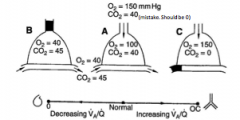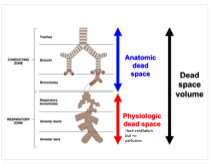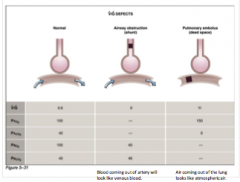![]()
![]()
![]()
Use LEFT and RIGHT arrow keys to navigate between flashcards;
Use UP and DOWN arrow keys to flip the card;
H to show hint;
A reads text to speech;
18 Cards in this Set
- Front
- Back
|
What does V/Q stand for? |
Alveolar Ventilation/Perfusion (blood flow) ratio |
|
|
What should V/Q normally equal? |
1. Relative to each other, balanced ventilation and perfusion. Optimal and equal gas/blood exchange over a period of time in the alveoli. |
|
|
What is V/Q impacted by? |
Partial pressures of O2 and CO2 in the blood. |
|
|
When does V/Q = zero |
When ventilation is 0 (perfusion continues). Zero divided by anything is zero. |
|
|
When does V/Q equal infinity? |
When Perfusion is essentially 0. Any number divided by zero is infinity. No new blood coming into lungs. |
|

What is V/Q at A, B, C |
A = 1, normal B = 0, no ventilation C = infinity, no perfusion. |
|
|
What is it called when V/Q deviates from the normal? |
V/Q mismatch or V/Q inequality |
|
|
When would V/Q = 0 occur? |
Atelectasis: small airway collapse from compression, hypoventilation, absorption of oxygen. - short breaths, dark lung colour.
|
|
|
What is a shunt? |
When V/Q = 0 and blood perfusing a part of the lung will return to the heart without releasing CO2 or picking up O2... blood is being shunted from the right side of venous circulation to the left side arterial circulation without any gas exchange. |
|
|
What is hypoxic pulmonary vasoconstriction? |
When PAO2 < 70mmHg it induces constriction in the arterioles that supply that area of hypoxic alveoli. This response is activated by O2 levels in the alveolus themselves and ultimately, blood is diverted from poorly ventilated areas of the lung to minimize shunt effect. i.e. happens in lung surgery, "altitude sickness" |
|
|
What might cause V/Q to equal infinity? |
Blood clot, profound hypotension (low BP), pulmonary embolism, shock may stop perfusion. |
|
|
What is "dead space ventilation"? |
When V/Q = infinity, a volume of gas is being moved in and out of the body but no gas exchange is occurring. Air just moves through lungs without gas exchange. |
|

How can you minimize dead space volume (physiologic) when necessary? |
Drugs. *Know where each dead space is. |
|
|
What does V/Q < 1 mean? |
Ventilation is lower, but perfusion is still adequate. |
|
|
What does V/Q > 1 mean? |
Perfusion is lower, but ventilation is still adequate. |
|

Where do you find these problems (i.e. what zone of the lungs)? |
- Zone 1,2,3 go dorsal to ventral - Dorsal areas have higher V/Q ratios (>1) since more ventilation then perfusion. Air is lighter than blood - Ventral areas have lower V/Q ratios (<1) since more perfusion then ventilation. Blood pools due to gravity. |
|

Are these issues more severe in larger or smaller animals? |
Large! Do not want them to lay down. |
|
|
How do we deal with V/Q issues? i.e. during surgery to get lungs and chest wall functioning as a unit again, change which "zones" are being focused on. |
- drain air or fluid - fix diaphragmatic hernia - supplemental O2 - fluids (i.e. increase BP to increase CO to get blood to under perfused areas - change body position |

